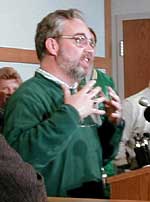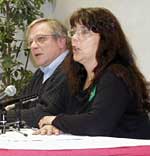State workers' strike ends
By Michael Khoo
Minnesota Public Radio
October 14, 2001
State negotiators have reached a tentative contract agreement with union leaders that is expected to end a two-week-old strike by state workers. The agreement was announced early Sunday morning after three days of nearly around-the-clock talks. All sides say they were able to achieve some of their key goals.
| |
|
|
|
||
Peter Benner, the executive director of the American Federation of State, County, and Municipal Employees, Council 6, says the new contracts fall short of the union's initial demands, but he says agreements make progress in some important areas.
"We think we accomplished a number of our key goals on wages; we think we accomplished some very key goals on health care. But is it what we would have liked it to be? No, not in every respect. Being an employer of choice in these times means some major committments in how the work force is treated," Benner said.
The contract deals, reached just after 2 a.m. Sunday, gives American Federation of State, County and Municipal Employees 3.5 percent wage increases for each of the next two years, said Don Dinndorf, spokesman for the union's Council 6. Workers belonging to the Minnesota Association of Professional Employees would receive 3 percent pay hikes for each of the two years.
Both unions also would see "significant improvements" in the health care package over what the state had offered before the strike, Dinndorf said.
"This is the offer that should have been the floor offer in July," said Deb Schadegg, MAPE president. Union members will return to work until a rank-and-file vote is taken, which probably wouldn't happen for several weeks, Dinndorf said.
The final state offers before the strike included back-to-back 3 percent raises for all AFSCME employees for two years and a one-time 4 percent across-the-board raise for MAPE's members.
AFSCME had asked the state for a 5 percent across-the-board raise each of the next two years. For MAPE, the union sought 4.5 percent raises annually.
| |
|
|
|
||
Carter said Gov. Jesse Ventura was kept abreast of developments and gave his approval to the final deal. Carter says administration officials are pleased workers will be returning to work shortly. But he says making the transition from the picket line to the workplace and perhaps repairing damaged relationships will require sensitivity and time.
MAPE Executive Director Jim Monroe concurs. "It's not going to be an overnight transition. It's not going to be turning the light on and off. And it's going to take some time for people - in some cases maybe not at all - to get back to old friendships or relationships," Monroe said.
Carter didn't rule out layoffs as a way to pay for the contracts, but said he would leave it to state agencies to determine how to trim money from their budgets. "We certainly would hope that's not likely," Dinndorf said of possible layoffs. The unions have contended all along that the state had more money available than it had offered to the unions.
Lisa Maidl, a revenue collector in Ely, said she was satisfied with the pay increase but was still leery about the health benefits. She was waiting hear the specifics. "That will be the determining factor," she said. Maidl said she's looking forward to receiving a paycheck, but she's also nervous about returning to an office were more than a dozen union members crossed the picket line and continued to work.
"There's a lot of hard feelings," Maidl said. "I'm just going to go in, sit at my desk and hopefully avoid some of those people for awhile."
Since the strike began, managers were pulling double-duty and as many as 1,000 members of the Minnesota National Guard had been helping out in nursing homes, veterans homes, security hospitals and treatment centers. Services were disrupted in some state agencies, but no major problems were reported.
Workers went on strike Oct. 1, three weeks after the Sept. 11 terrorist attacks, and the timing has been a public-relations challenge for union members.
Poll results released Friday found that more than half of respondents felt it "wrong for state employees to be on strike now." The Star Tribune newspaper poll also found people more sympathetic to the administration's position than to the unions'. Minnesota's last state workers strike, in 1981, involved 14,000 employees and lasted 22 days.
The Associated Press contributed to this report


